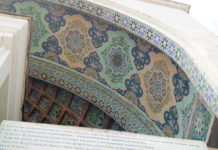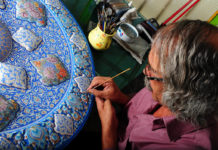Baecheopjang refers to the art of baecheop, a technique of preserving a painting or calligraphic work by adhering a sheet of paper or silk to its back to make it into a scroll, frame ar folding screen. The technique originated in China. Baecheop is a name imported during the Japanese rule; it now is called pyogu. The technique enhances the beauty and practical quality of a work as well as preserving it.
The production technique itself varies in accordance with the five distinct types of work to which it is being applied: frames, folding screens, scrolls, cover designing and antique document processing. The manufacturing process for hanging pictures is as follows: Attach folding paper three times (chobae, jaebae, and sambae) and put on chukmok and bandalmok after drying it. The glue used is a paste of flour and water which is fermented over as long as a decade. First, two large sacks of wheat flour are poured into an onggi earthenware jar, which is then filled with water to distill the solution. Whenever the water gets foamy, it is poured out and replaced with fresh water to continue the distillation. This is a process for making the basic ingredient of an all natural glue that is bacteria-and mold-free and does not spoil. The solution should be left to distill for about 10 years; throughout the process, the water is changed repeatedly to yield a white flour cleansed of all yellowish impurities. The flour is strained through a fine sieve and dried into a powder, ready to be made into glue as needed.
The backing paper (hanji) is made from the inner section of mulberry bark with the cleanest of water. The thickening agent is often made by dissolving highly viscous hibiscus in lye. White clay is added to the vat of pulp and water.
Framing has several steps: layering silk fabric, first coating of paint, second coating, drying and preparing frame, and assembling. The procedure for making a section of folding screen follows the same step. The production procedure for a scroll is as follows: cutting, first coating, second coating, drying, third coating, drying, preparing a wood framing and attaching the crescent. This process sometimes involves repairing old books with the damaged cover or pages.
Kim Pyoyeong learnt his skills first from his cousin, Yun Byeong-se, then studied under the master Kim Yong-bok. He teaches at the Artwork Mounting Training Koreana i Spring 2012 Institute in Bongmyeong-dong, Cheongju, which offers a weekly class for young people.
The Institute for Preserving Korea’s Paper Cultural Heritage was established in 1992 and he waas registered as Cultural Heritage Maker





